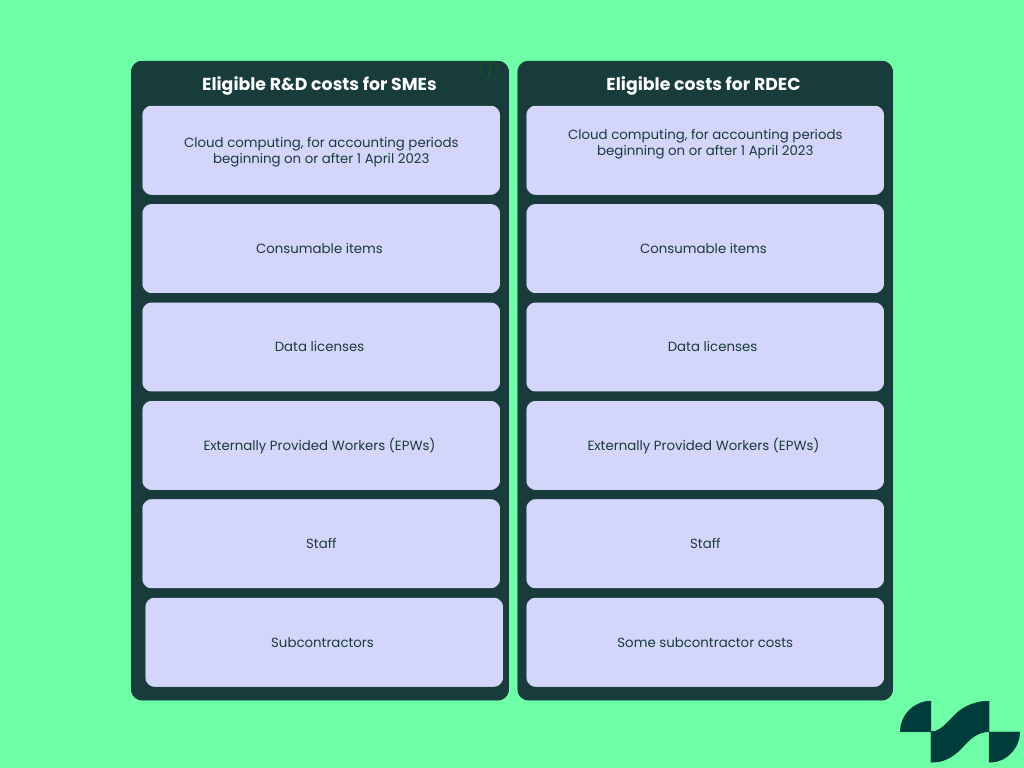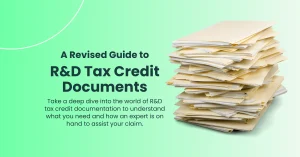What is the R&D additional information form (AIF) ?
31 October 2023

The R&D additional information form (AIF) processes of claiming for R&D continually change such as the introduction of the R&D additional information form from the 8th August 2023 that needs to be completed prior to the claim. This form is required for claims for both the SME and RDEC tax incentives. Let’s dive straight into what the purpose of this form is and all the essential information you need to know for your upcoming R&D claim.
What is the purpose of the R&D additional information form?
The purpose of this form is to ensure HMRC has all the information they need to understand your claim, it helps them analyse your eligibility smoothly. It is mandatory to complete this, failure to do so will result in HMRC removing your R&D claim from your company tax return. This form helps HMRC to effectively administer the scheme, analyse authentic eligibility by improving the quality of claims, and prevent abuse of R&D. Essentially if they have all the key information in front of them, they’ll be less likely to send out enquiries about the gaps in information.
When was the R&D additional information form implemented?
The additional information form was made compulsory on August 8th 2023 and was one of the changes announced in April 2023, the others included:
- Increase in the RDEC tax relief rate.
- Decrease in the SME tax relief rate.
- Extension of new qualifying expenditures such as data licenses, mathematics, and cloud computing costs.
- A new notification process starting April 1, 2023: If you are new to claiming R&D tax credits or haven’t claimed them in the past three accounting periods, you must inform HMRC of your intention to submit an R&D tax credit claim. This notification is mandatory for both the SME and RDEC schemes.
- Ineligibility of overseas R&D activity delayed until 2024: The government had planned to introduce a new rule that limits R&D tax credit eligibility to activities conducted within the UK. However, this change has been postponed and will now be enforced from April 1, 2024. This geographical requirement also extends to externally provided workers (EPWs), who must perform their work within the UK to qualify for the tax credit.
From the 8th of August 2023, you must complete and submit an R&D additional information form to HMRC to support all your claims for Research and Development (R&D) tax relief or expenditure credit. This includes claims for the end of the 2022 tax year.
Find out more about the R&D tax credit changes.
What details are needed for the R&D additional information form?
Instead of sending a PDF attachment with your CT600, the additional form is an electronic version of the claim report that is directly submitted to HMRC’s systems. This needs to be completed before the company tax return. In order to complete this electronic form, you need the following information to hand:
Company details
This includes your VAT registration number, Unique Taxpayer Reference (UTR), employer PAYE reference number, and Standard Industrial Classification (SIC) code.
Contact details
The details of the most senior person in your team who is responsible for the R&D claim such as a director. Or any agent involved in the claim who can claim on behalf of the company.
The details of your project | How were you involved in R&D?
HMRC want to know the number of R&D projects you’re claiming for and their details around the topics of:
- What is the main field of science or technology that resonates most with the nature of your project?
- Prior to your project, what was the baseline understanding or state of science or technology that your project intended to progress from?
- Using the answer to the previous question, state the aim of your project; quantify or explain how you wanted to progress from what was already known.
- Throughout the project, what scientific or technological uncertainties arose?
- How did you attempt to overcome these uncertainties?
Select the scheme you’re claiming for: SME or RDEC
The R&D tax credits you’ll receive, if your claim is successful, depend on what scheme you’re applying for because they have different relief rates. Therefore, in the information form, you’ll need to select which scheme you’re applying for and provide the amount you’re eligible for. For larger companies, it will be RDEC and for small and medium-sized enterprises, it will be the SME incentive, although there are some exceptions so it’s worthwhile to double-check with an R&D specialist.
Our free R&D tax credit calculator can help you calculate which you can submit as an estimate in your form, ready for HMRC to check.
The details of your R&D qualifying costs
Inform HMRC of your qualifying R&D expenditure:

The details of qualifying direct and indirect activities
Indirect activities are the tasks that are part of a project but don’t directly contribute to solving the scientific or technological uncertainty. Essentially, they are the activities that helped facilitate and support the direct R&D work. Examples include:
- Scientific and technical information services, specifically when they are carried out to support R&D, such as creating the initial report on R&D findings.
- Indirect support activities like maintenance, security, administrative and clerical tasks, financial, and personnel activities such as paying R&D staff, but only when they are conducted for R&D purposes.
- Supplementary activities necessary for conducting R&D, for instance, hiring and compensating staff, renting laboratories, and maintaining R&D equipment, including computers used for R&D.
- Training that is needed to complete the R&D project.
- Research conducted by students and researchers at universities.
- Research activities (including related data collection) aimed at developing new scientific or technological testing, survey, or sampling methods, provided this research isn’t considered R&D on its own.
- Feasibility studies that inform the strategic direction of a specific R&D activity.
Details of each project
In cases where you have more than one R&D project you’d like to claim for, you’ll need to provide:
- A full description of qualifying expenditure if your claim includes 1-3 projects.
- A description that provides 50% coverage of the qualifying expenditure if you’re claiming for 4-10 projects, with a minimum of 3 full descriptions.
- A description that provides 50% coverage for qualifying expenditure if you’re claiming for 11-100 but you need to provide 10 complete explanations for the projects with the highest qualifying expenditure.
The start and end date of the accounting period you’re claiming in
The accounting period’s beginning and ending dates for which you are seeking tax relief must align with those specified in your Company Tax Return.
Who can submit the R&D additional information form?
Either a representative of the company or an agent acting on behalf of the company can submit the additional information form. You’ll need to provide this person’s contact details in the form.
When to submit the additional information form for R&D tax credit claims?
The additional information form should be sent to HMRC prior to submitting the company’s Corporation Tax Return. Failure to do so will prompt HMRC to contact the company to verify the removal of the R&D tax relief claim from the Company Tax Return.
In case you’ve already submitted your tax return and subsequently submitted the R&D additional information form, you will need to file an updated tax return. The initial tax return will be replaced by the amended version.
Common Pitfalls in Filling Out the AIF
Completing the Additional Information Form (AIF) for R&D claims can be challenging. Here are some common pitfalls to avoid:
- Incomplete Information: Ensure all fields are filled out completely and accurately.
- Lack of Supporting Documentation: Attach all necessary documents to support your claim.
- Incorrect Calculations: Double-check all financial figures to avoid errors.
Step-by-Step Guide to Completing the AIF
A thorough guide can help streamline the process. Follow these steps to complete the AIF:
- Gather Required Documents: Before you start, ensure you have all necessary documents, such as financial records and project reports.
- Fill Out Personal and Company Information: Enter accurate details about your company and the individuals involved in the R&D project.
- Describe the R&D Activities: Provide a detailed description of the R&D activities, including objectives, methodology, and outcomes.
- Financial Information: Accurately report all financial information related to the R&D activities.
Detailed Examples of Successful AIF Submissions
Learning from successful submissions can be highly beneficial. Here are some detailed examples:
- Example 1: A software development company successfully claimed R&D tax credits by detailing their innovative algorithm development process.
- Example 2: A biotech firm described their breakthrough in developing a new drug, including all experimental stages and results.
How to submit this form?
The form needs to be submitted electronically.
What happens after finalising the additional information for R&D?
HMRC will notify you that they’ve received your form and they will provide a reference number. The next step is to start your R&D claim!
How has the R&D additional information form changed Alexander Clifford’s processes?
At Alexander Clifford, we always collect the information required for the additional information form during our technical call with every client. This means we collect the essential information for both the form and your claim at the same time and take leadership over the full R&D claiming process, guiding you through your role in it. We’re well prepared for all the changes that have been rolled out to the R&D incentive and these haven’t impacted our success level due to our detailed compliance processes.
Do you need support for your R&D claim?
In conclusion, the introduction of the R&D additional information form in August 2023 represents a significant shift in R&D tax credit procedures, aiming to enhance the accuracy and efficiency of claims. This form, obligatory for SME and RDEC tax incentives, plays a crucial role in ensuring HMRC’s comprehensive understanding of all R&D claims. It is vital to complete and submit the form alongside your company’s tax return to prevent claim removal. Don’t miss out on the incredible opportunity of R&D by using the trusted choice of R&D credits, Alexander Clifford. Contact us today and we’ll explain why our compliance processes are providing a very important financial boost to our client base and how this can help provide you with a competitive edge to your business.







